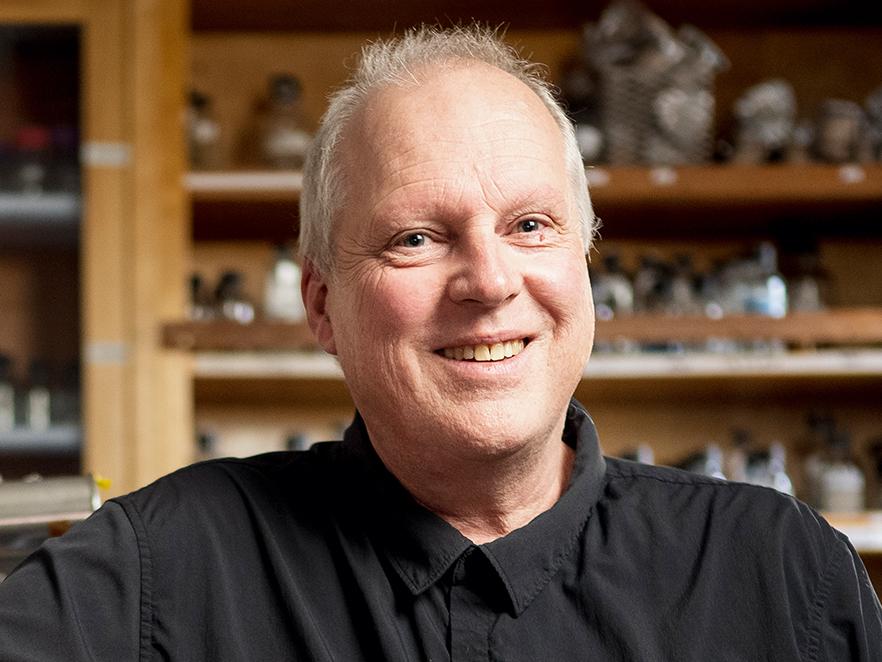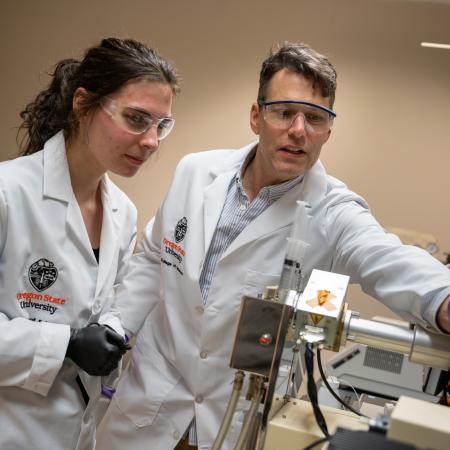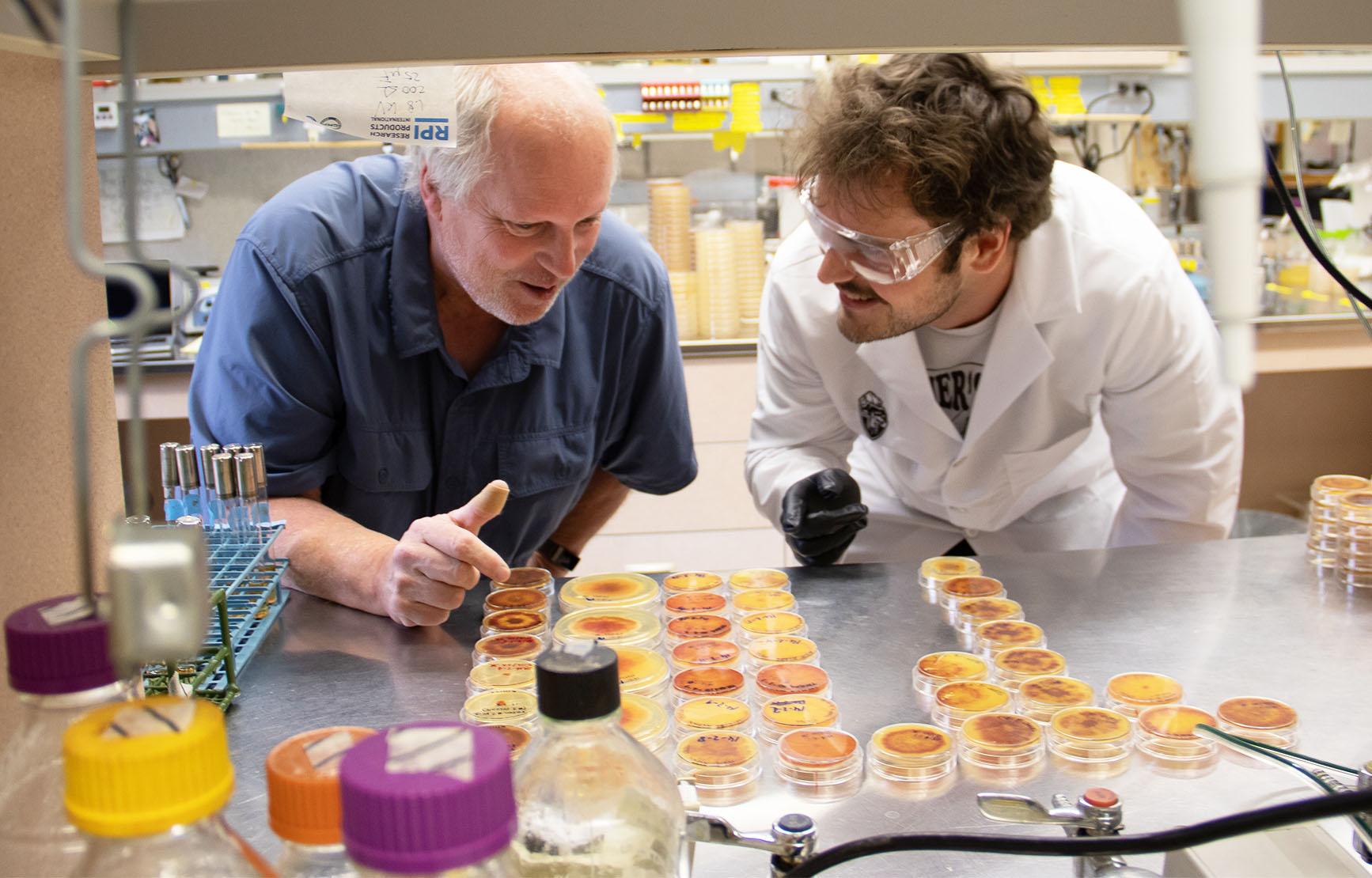Cellular and molecular biology is an interdisciplinary field that studies the structure, function, and regulation of cells, and the role of biological molecules involved in these processes. Research involves aging and the role of macronutrients in promoting healthy functions. Several research programs involve the study of cell signaling and its role in immunity and neural function.
Cellular and molecular biology researchers
Research faculty are accepting new graduate students unless designated with (*).

Alysia Vrailas-Mortimer

Alysia Vrailas-Mortimer
The Vrailas-Mortimer lab focuses on how different factors such as aging and exposure to toxins (pesticides and heavy metals) contribute to neurological disorders and muscular dystrophies. A common feature of aging, exposure to toxins, and many diseases is increased levels of oxidative stress (oxygen radicals that are highly damaging to DNA, proteins, and other cellular structures). Therefore, my lab explores how stress response genes play a role in regulating aging and toxin exposure and how this contributes to a disease state. In order to address these questions, we use the genetic model organism Drosophila melanogaster (fruit fly), which has been instrumental in our understanding of many neurological and muscle disorders.
View her profile

Nathan Mortimer
Research in the Venom Biochemistry & Molecular Biology lab is focused on understanding signal transduction pathways, which enable cells to respond to stimuli through changes to the cells’ physiological or biochemical state. These signaling pathways play important roles in multiple processes, including the immune response to pathogen infection. Signal transduction pathways are tightly regulated, and deregulated cell signaling contributes to the pathogenesis of many diseases. We use the Drosophila-parasitoid wasp system in which parasitoids manipulate host signaling via venom virulence factors that are transferred during infection. We find that parasitoid venom proteins target conserved host signal transduction pathways, and so by characterizing the molecular interactions between host and parasite, we hope to better understand pathway regulation and identify novel signaling regulators among parasitoid venoms.
View his profile

Adrian F. Gombart

Adrian F. Gombart
Our research focuses on mechanisms by which vitamin D and plant compounds affect immune function with the goal of preventing or treating disease. Using molecular and bioinformatic techniques, cell culture and mouse models, we focus on: i) identifying how infection affects gene expression and immune response by the vitamin D pathway; ii) identifying how xanthohumol from hops mediates obesity and metabolic syndrome benefits by interactions with the host and microbiota; and iii) developing nanofiber bandages that release vitamin D to reduce infection and speed healing. We also perform small clinical trials to determine the effect of micronutrients on immune function.
View his profile

Colin Johnson

Colin Johnson
It is estimated that approximately one fourth of genes in genomes encode for membrane proteins. The Johnson lab is interested in structurally and functionally characterizing membrane proteins with a focus on calcium signaling. Specifically, we are focused on the ferlin gene family, an evolutionarily ancient set of genes which encode for a group of calcium sensing vesicle proteins which act in a broad range of physiological processes ranging from neurotransmitter release to cell repair and fertility. In addition, mutations in ferlin genes have been directly linked to pathologies including deafness, muscular dystrophy, and breast cancer. To increase our understanding of ferlin signaling and disease, we are reconstituting wild-type and mutant ferlin proteins into synthetic liposomes and lipid nanodiscs, allowing us to study ferlins in a biomimetic in vitro system.
View his profile

Elisar Barbar
Almost all research on protein structure has been performed on purified proteins. The Barbar lab is implementing strategies for probing protein conformation, dynamics, and interactions in physiologically relevant cellular environments. We are starting to use NMR for characterizing proteins in live cells. We are also interested in fluorescence-based techniques, including fluctuation spectroscopy and FRAP, which characterize protein interactions and diffusion. We apply these techniques to determine mechanistic roles for functions of LC8 and its client proteins, and are especially interested in finding a role for LC8 protecting cells from cancer through interactions with the tumor suppressor, 53BP1.
View her profile

Kenton Hokanson

Kenton Hokanson
Dr. Hokanson directs OSU’s Electrophysiology Facility. His team uses patch-clamp and extracellular electrode array recordings to characterize the electrical activity of neurons (including brain slices, primary cultures, and cell lines). Our projects include functional characterization of neurons carrying human-disease-linked mutations, screens of botanical compounds for neuroactive properties, pharmacological investigations into the mechanisms driving circadian rhythm in newly-created cell lines, and leveraging neuronal coculture systems to describe synaptic transmission within the gut-brain axis. We also provide consulting and experimental planning, text and preliminary data for grant submissions, data analysis, and access to specialized laboratory equipment.
View his profile

Sarah Clark
What is the molecular basis of touch sensation? Organisms sense and interact with their environment through the perception of mechanical stimuli such as touch, vibration, temperature, and sound. Specialized sensory neurons in the skin and inner ear detect mechanical stimuli and convert it into an electrical signal through the opening of ion channels in the cell membrane. The Clark lab studies the architecture and mechanism of mechanically-activated ion channels to understand the molecular basis of touch sensation. We use C. elegans as a model system and apply a variety of biophysical and biochemical methods to our work, including cryo-electron microscopy (cryo-EM), fluorescence microscopy, TIRF microscopy, and patch-clamp electrophysiology.
How are lipids trafficked to the cell membrane? Lipids are synthesized in the endoplasmic reticulum (ER) and moved to different organelles via non-vesicular and vesicular trafficking. Non-vesicular lipid trafficking is carried out by lipid transport proteins, large macromolecular complexes that form a bridge between membranes at organelle-membrane contact sites. Lipid transport proteins are proposed to act as ‘lipid firehoses’, rapidly shuttling single lipids between donor and acceptor membranes. We use cryo-EM, as well as other biophysical and biochemical techniques, to study the architecture of lipid transport protein complexes with the goal of understanding the mechanism of lipid transport.

Assistant Professor
Dan Liefwalker
MYC is a master transcription factor regulating up to 30% of the genome and involved with cellular function and cell fate. In cancer, the transcriptional activity of MYC has been implicated in up to 70% of all cancers and is involved in all the hallmarks of cancer phenotypes. The Liefwalker lab seeks to unveil the critical features of MYC-dependent directives that drive transformation into malignant cell types.
View his profile

Tory Hagen*
The Hagen research group seeks to identify the mode of action of two “age-essential” micronutrients, lipoic acid (LA) and acetyl-Lcarnitine (ALCAR). Our work has shown that ALCAR and LA improve two of the most important cellular lesions of aging: the inability to respond to oxidative and toxicological challenges and the loss of mitochondrial function. We are currently exploring why these stress response mechanisms decline with age and are particularly focusing on cellular signaling pathways that LA may induce to activate Nrf2-mediated gene expression. Mitochondria may be the “Achilles’ heel” of cellular aging because their dysfunction adversely affects conversion of dietary fuels into useful energy, dysregulates cellular calcium levels, increases oxidative stress, and limits tissue renewal. Another goal of my laboratory is to determine whether these age-essential micronutrients can improve human health by maintaining mitochondrial function.
View his profile

Michael Freitag*
Epigenomes are the sum of DNA or protein modifications that result in heritable states not encoded in the DNA sequence. Posttranslational modifications play important roles in all aspects of eukaryotic gene regulation. Evidence from cytological, biochemical and genetic studies showed that transcriptionally silent "heterochromatin" is distinct from active "euchromatin" in both DNA composition and epigenetic modifications. We address evolution and function of constitutive and facultative heterochromatin by comparative biology, using fungi as our model systems. We investigate genome-wide epigenetic regulation by ChIP-seq, RNA-seq, and Hi-C. Our current focus is the regulation of histone H3 lysine 27 methylation (NSF grant MCB1818006).
View his profile

Associate Professor - Immunology
Brian Dolan
Work in my laboratory focuses on the adaptive immune system, a unique feature of vertebrates where the sensors of the body responsible for preventing diseases recognize the specific molecular patterns of diseases that allow discrimination between healthy tissues and those that would harm the body. We focus on the MHC class I antigen presentation pathway, the process by which cells alert the adaptive immune system to the presence of intracellular pathogens. Antigen presentation relies on the degradation of foreign proteins into short peptide sequence which can then bind to the MHC class I molecule. Once bound, the peptide-MHC class I complex is displayed on the cell surface for surveillance by cytotoxic CD8+ T cells that are looking for evidence of specific diseases. We are attempting to answer questions related to the precursor antigenic protein’s synthesis and degradation. Evidence is accumulating that many of these precursor proteins are degraded quite rapidly following their synthesis and we are attempting to pin down the cellular mechanisms that control such rapid protein turnover and how it relates to antigen presentation. Many of our studies focus on the role of the protein ubiquitin and other ubiquitin-like proteins that are involved in a range of cellular functions. We are studying many different aspects of ubiquitin modification to identify the enzymes that dictate how successful antigen presentation occurs. Our long term goals are to modulate antigen presentation with a variety of chemical inhibitors of the ubiquitin pathway.
View his profile

Jessica Siegel*

Jessica Siegel*
Dr. Siegel examines the acute and long-term neurobiological effects of psychoactive substances using a mouse model. Recent work has focused on the acute and long-term effects of methamphetamine and ketamine on serum corticosterone levels and tyrosine hydroxylase and phosphorylated tyrosine hydroxylase levels in the hippocampus and striatum. Neurobiological effects of drugs are correlated with behavioral and cognitive effects in order to understand how drugs alter behavior and the neurobiological mechanisms of these behavioral and cognitive effects.
View her profile

Siva Kolluri (adjunct)

Siva Kolluri (adjunct)
Kolluri Laboratory research efforts are directed toward understanding the molecular mechanisms of carcinogenesis, discovering molecular targets that are selective for cancer, developing agents that are selectively toxic to cancer cells, and devising optimal combinations of therapeutic agents aimed at different molecular pathways for the prevention and treatment of cancer. We are currently focusing our efforts to (i) Develop small molecules to treat Bcl-2 overexpressing cancers and (ii) Therapeutic targeting of the Ah Receptor in cancer and (iii) Activation of cell cycle regulators to suppress cancer cell growth.
View his profile

Arup Indra (adjunct)

Arup Indra (adjunct)
The Indra laboratory is involved in collaborative multi-investigator supported research (molecular, cellular, biochemical and computational) to elucidate the mechanisms underlying the crosstalk between skin-cells and role of microenvironment in atopic-dermatitis, vitiligo, tumor-heterogeneity and in metastatic melanoma. We discovered novel signaling mechanisms and identified different factors that regulate UV-induced melanocyte/epidermal stem-cell survival, proliferation, migration and invasion. In collaboration, we are also studying the mechanisms of tissue regeneration and healing of delayed/chronic wounds. The anti-cancer, anti-oxidant, anti-inflammatory and anti-ageing properties of bioactive natural compounds and small molecule regulators are further studied as our drug-discovery initiative.
View his profile

Kathy Magnusson (adjunct)

Kathy Magnusson (adjunct)
The Magnusson lab's main goal is to find interventions for aging that will help to maintain the quality of life into old age. Ultimately we want to discover the mechanisms underlying the age-related changes in the N-methyl-D-aspartate (NMDA) receptor, which is very important for the formation of memories. This receptor uses glutamate as a transmitter, and shows greater declines in binding of glutamate with increased age than any of the other glutamate receptors. They are also interested in helping to better understand the function of the NMDA receptor in different brain regions and hope to determine exactly what role NMDA receptors in the prefrontal cortex play in different forms of memory.
View her profile
Latest Stories
Across the Department

GCE4ALL leads global advancements in genetic code expansion for advanced therapies










